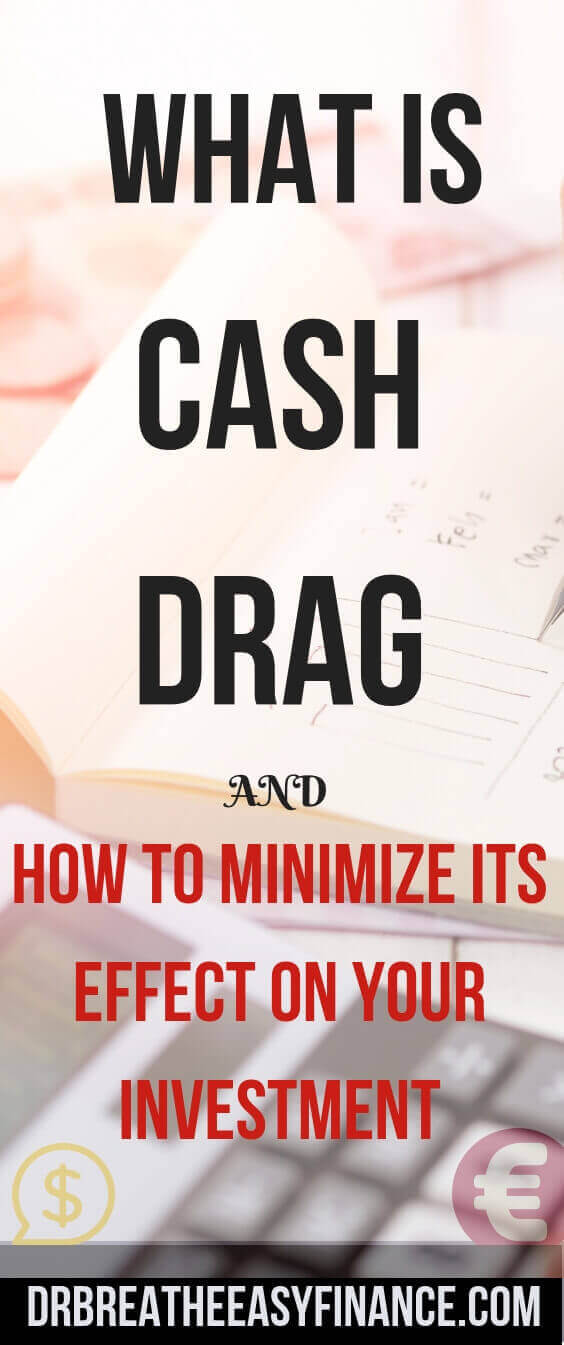Understanding the concept of “time value of money” can be a bit tricky, to say the least. In short, the value of money goes down over time, and the cost of products and services go up over time. Having said that, is it a good idea to hold cash in your investment portfolio? If so, why?
Holding cash in your portfolio for too long can create a negative impact on your returns, often referred to as “Cash Drag” or “Performance Drag”.
I do get the reason why many people hold on to cash though, cash gives people that feeling of security and cash is king like they say right?
From the introduction, you should already feel the drag about this post. Joking. But the term drag itself does have a negative vibe to it.
Due to the time value of money (the fact that the buying power of money drops over time), there is an opportunity cost to holding onto cash that can negatively impact your portfolio.
Here’s an introduction to the basics of cash drag, how to minimize the negative impact it can have, and why it’s important to know the related consequences.
Table of Contents
What Is Cash Drag And How Can You Avoid It?
We will not get into the nitty-gritty of the time value of money as we already wrote an awesome post about it. Suffice to say, that the value of one US dollar, or any currency for that matter, drop over time.
Just think of the times your grandparents told you a story about how a candy bar only cost a nickel at the grocery store down the road. What does a candy bar today cost? Certainly not a nickel!
The concept of time value of money, along with inflation, increasing prices, etc. cause the purchasing power of one dollar to decline over time.
Inflation alone is estimated to be about 3% per year, meaning the purchasing power of one dollar drops about 3% each year.
If you don’t believe me, try this smart asset inflation calculator for yourself. We also talk about how 1 million dollars is not what it used to be any more in our post about Roth IRA millionaire.
Cash drag refers to the negative effects of holding onto cash for too long can have on your investment portfolio. As we assumed inflation to be set at 3% per year, that means the purchasing power of one dollar drops 3 cent yearly. If your investment is not returning at least 3%, inflation will eat your money alive.
An Example of Cash Drag & The Negative Impacts It Can Have
Sarah is an avid investor who enjoys investing in the stock market.
Sarah is conservative in nature and seeks to diversify her portfolio in such a way that she doesn’t lose too much on her investments.
Sarah currently has $30,000 saved up to invest. She decides to invest $15,000 into a basic S&P 500 index fund while keeping the other $15,000 in cash to avoid a large loss should the market decline.
At the end of the year, she sees that her invested money had a total of 9% return on $15,000, bringing the value of the invested portion of her money to a total of $16,407.10.
Try out our compound interest calculator to play around with the numbers yourself.
She gained a total of $1,407.10 from her invested money. She also saw reports showing inflation for that year were estimated to be 3%.
What were the consequences (good or bad) of keeping $15,000 invested in cash?
1. The opportunity cost of $15,000 invested in cash
Opportunity cost is the cost of forgoing the benefits of decision B because you chose decision A.
In Sarah’s case, she lost the opportunity of gaining a 9% return on another $15,000, because she chose to keep that $15,000 invested in cash.
Had Sarah decided to invest her full balance into the S&P 500, she would have made an additional $1,407.10.
2. The cost of inflation
Sarah mentioned that inflation for that year was 3%. This means that the purchasing power of one dollar dropped 3%, or that the overall cost of goods and services increased by 3%.
As a result, her investment (money in cash) theoretically saw a negative return on investment. I know what you’re thinking…”Yeah but she still has the $15,000 in cash, so how did she lose money?”
Here’s another way to look at it: Sarah’s $15,000 at the beginning of the year had the purchasing power to buy 15,000 candy bars priced at $1 each.
At the end of the year, inflation caused the prices of products to increase by 3%, meaning that candy bars now cost $1.03 each rather than $1.
As a result, she still has $15,000 in cash but can only purchase 14,563.11 candy bars priced at $1.03. In other words, she lost 3% on her money!
3. The “Cash Drag” on her overall portfolio
Because Sarah carried a high balance of her portfolio invested in cash, her total returns were actually lower than 9% when you take into account inflation. In other words, her cash “dragged” down the overall performance of her investment portfolio, hence the term “Cash Drag.”

How To Avoid The Negative Impact of Cash Drag
By implementing only a few small changes to your portfolio, you can be sure to avoid the negative consequences of cash drag, while properly diversifying your portfolio to meet your desired risk tolerance.
1. Automate your investment accounts
Often times, cash drag is a result of having money transferred from your bank to your investment account, yet to never have any investment transactions occur.
Thus, your money sits in cash and builds up over time. Just like setting up an automatic transfer from your bank account to your investment account, most banks will allow you to set up automatic investments once your cash balance in the investment account reaches a certain level.
By activating these features in your investment account, you can automate your investments and avoid holding onto cash for too long.
2. Keep a separate emergency fund
Many people, like Sarah in the example above, keep their money in cash to avoid losing it all should the market decline.
However, if Sarah had a properly funded emergency account that was separate from her investment accounts, she could have the peace of mind that she won’t lose all her money in a down market.
Furthermore, should a down market occur, she would more likely be able to keep her money invested until the market bounced back because she has an emergency fund to act as a cushion meanwhile.
3. You don’t need a gazillion emergency fund. Optimize your emergency fund
There are different rules of thumb on the optimal emergency fund. What I felt most people settle on is the Dave Ramsey one of 3-6 months of emergency fund.
We actually love emergency fund so much, that we listed it as part of the foundation of a solid financial pyramid.
Also part of our 12 toddler steps to financial freedom. That one some steps we don’t agree with Dave Ramsey about. The emergency fund was not one of those, however.
Think about it though, if you are really going to be in an emergency situation, chances are, you would not need a big emergency fund, and if you do, you would probably need it one chunk at a time.
You would probably need one month of expenses, at a time.
Your taxable account can serve as your second tier emergency fund. You can access this fund before your next rent is due.
4. Have your dividend-paying stocks reinvested
Many companies pay decent dividends on a regular basis. You have the option to have the dividends given to you in cash, sent to you in a check, or simply have them reinvested into your investments.
In most cases, it’s best to have them set up to be reinvested into your portfolio unless you are retired and rely on those dividends to pay you an income each month.
It’s another common mistake to have your dividend-paying stocks just sent to your investment account in cash, building up a cash balance over time and creating “cash drag” on your overall portfolio.
5. Diversify your investments between stocks and bonds
Just like in Sarah’s example above, she was afraid of losing all her money, so she only invested half of the balance.
To go a step further of keeping an emergency fund, it’s also a great idea to properly diversify your money among both stocks and bonds to hedge against potential losses.
If Sarah wanted to invest her money at a moderate investment portfolio, she could invest the full $30,000 among 70% stocks and 30% bonds.
The stock market and bond market often react conversely, so when the stock market declines, often times the bond market remain stable or even improves.
Having an appropriate mix of stocks and bonds will add to her peace of mind that she is mitigating her potential losses while maximizing on her overall returns.
The Formula To A Successful Investment Portfolio
When all is said and done, by implementing proper investment strategies and basic personal financial concepts, chances of the negative effects of cash drag hurting you are slim to none. Among the most basic concepts to a well-balanced investment portfolio and basic personal finance strategies are:
- Keep a budget and update it regularly.
- Have a separate emergency fund of at least 1 month of living expenses, if not 3-6 months of living expenses.
- Pay down bad debt such as credit cards, personal loans, car loans, etc. as fast as possible
- Invest regularly and hold onto your investments for the long run
- Automate your investments so that your investments always get invested into the market when reached a certain balance (may differ between investment banks)
- Set up your dividend-paying stocks to be reinvested when dividends are paid.
- Diversify your investments properly among stocks and bonds, according to your investment objectives and appropriate risk tolerances.
- Review and update your investment portfolio on a regular basis to make sure it meets your goals and current life situations.
Cash drag doesn’t have to have a negative effect on your portfolio, and when understood properly, you will reap the benefits that many investors are forgetting to take advantage of. By following these basic steps and advice, no doubt you will avoid the negative effects of cash drag, and still have the peace of mind that you are well diversified and have a healthy emergency fund of cash when needed.
Please share and comment, let us know what you think. Agree or disagree.
I am a pulmonary and critical care doctor by day and personal finance blogger/debt slaying ninja by night.
After paying off close to $300,000 in student loan debt in less than 6 months into my real job, I started on a mission to help others achieve the same. There is no magic to this than to strap up and get it done. Some of the ways we achieved this include side hustle, budgeting, great negotiation skills, and geographical arbitrage.
When I was growing up, common knowledge in Nigeria is that there is one thing you cannot trust anyone else with, and you guessed it – your money.
Being frugal came easily to me based on my background. However, the concept of building wealth did not solidify in my mind until when I finished medical school. I wish I knew what I know now when I was 14. Still, I don’t know enough and I am constantly learning to improve my knowledge.
My goal is to reduce financial illiteracy among young professionals. I am catering to the beginners – babies and toddlers in financial literacy.








Chris says
Great article! I agree that having too much cash does set you up for less than stellar overall performance. (And there are times when I’m guilty of holding too much)
Finding that perfect balance and amount to mke you feel comfortable is key.
-chris
Adebayo says
You hit the nail on the head. The perfect balance is tough. Now that I am starting to dive into real estate, I find myself having more cash too. Go figure. But I felt it is needed so I can pay the 20% down if a property shows up. Just having tons of cash like drug dealers does cause a drag haha. Thanks for stopping by and taking the time to comment.